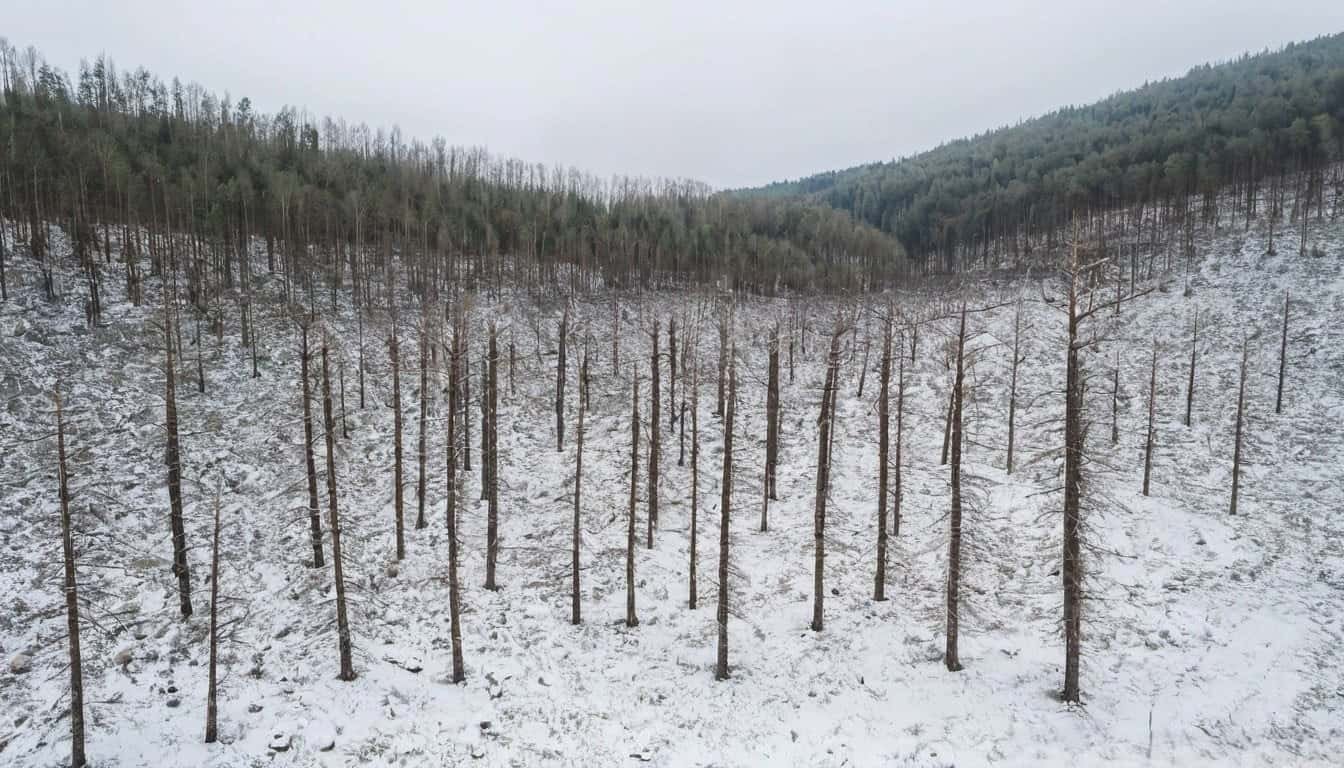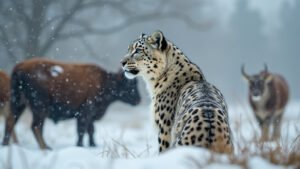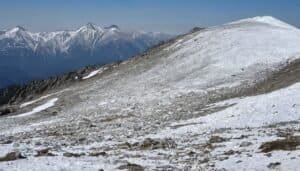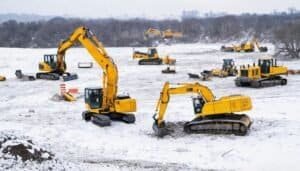Introduction
Snow leopards, the elusive big cats of the mountainous regions of Central and South Asia, face a severe threat from habitat loss. This article delves into how habitat fragmentation, climate change, and human activities are driving snow leopards towards endangerment
We’ll explore the primary causes of habitat degradation, its impact on prey availability, and the role of conservation efforts in mitigating these threats. Understanding these dynamics is crucial for developing effective strategies to preserve the remaining snow leopard populations
How Does Habitat Fragmentation Affect Snow Leopards?
Habitat fragmentation poses a significant threat to snow leopards by breaking up their already sparse and isolated habitats
This disruption impacts their territory and range, increases human-wildlife conflict, and makes it more challenging for them to find mates. Understanding these effects is crucial for developing strategies to preserve these majestic creatures
Impact on Territory and Range
Snow leopards require vast territories to thrive, often ranging across 12 to 39 square miles depending on prey availability and terrain. Habitat fragmentation reduces these expansive ranges, forcing snow leopards into smaller, less suitable areas
Fragmented habitats can lead to isolated populations, reducing genetic diversity and increasing the risk of inbreeding. The restricted movement also limits their ability to hunt effectively, as their prey is often scattered across large areas
According to a study by McCarthy et al. (2016) in the journal Biological Conservation, snow leopards’ territories have shrunk significantly in regions where human encroachment is prevalent. The study highlights that in fragmented landscapes, snow leopards are more likely to encounter human settlements, increasing the risk of conflict and retaliatory killings
Increased Human-Wildlife Conflict
As human populations expand into snow leopard habitats, encounters between these big cats and humans become more frequent
Snow leopards often prey on livestock when their natural prey is scarce, leading to conflicts with local communities. This can result in retaliatory killings by herders who view snow leopards as a threat to their livelihood
A report by the World Wildlife Fund (WWF) in 2017 emphasized that human-wildlife conflict is a major driver of snow leopard mortality. The report found that in regions like the Himalayas and the Tibetan Plateau, livestock predation by snow leopards leads to significant economic losses for herders, prompting them to kill the predators to protect their animals
Challenges in Finding Mates
Habitat fragmentation not only affects the snow leopards’ ability to hunt but also their ability to find mates
Snow leopards are solitary animals, and males must travel long distances to locate females during the breeding season. Fragmented habitats make these journeys more perilous and less successful, leading to fewer mating opportunities and, consequently, fewer cubs
The International Union for Conservation of Nature (IUCN) has noted that the breeding success of snow leopards is closely tied to their ability to move freely across their range. Fragmented habitats can lead to isolated populations with limited genetic exchange, which can reduce reproductive success and the overall health of the population
Primary Causes of Snow Leopard Habitat Loss
Snow leopard habitats are dwindling due to various anthropogenic activities that disrupt and degrade their natural environments
Key factors include urban expansion, agricultural development, and infrastructure projects, all contributing to the fragmentation and reduction of suitable habitats for these endangered cats. Understanding these causes is essential for addressing the root of their endangerment
Urban Expansion
Urbanization encroaches on snow leopard habitats as cities and towns expand into previously wild areas
The construction of residential, commercial, and industrial buildings leads to the destruction of forests and grasslands that snow leopards rely on for hunting and shelter. This expansion not only reduces the available habitat but also increases human-wildlife conflicts
A study by Li et al. (2018) in Global Ecology and Conservation highlighted that urban sprawl in regions like the Tibetan Plateau has significantly reduced snow leopard habitats
The study found that rapid urbanization, driven by population growth and economic development, has led to habitat loss and increased fragmentation, posing a critical threat to snow leopard survival
Agricultural Development
Agricultural activities, particularly in mountainous regions, lead to habitat loss for snow leopards. The conversion of wild lands into fields for crops and pastures for livestock reduces the area available for snow leopards and their prey
Additionally, agricultural expansion often involves deforestation and land degradation, further impacting the ecosystem
According to a report by the Food and Agriculture Organization (FAO), agricultural expansion in Central Asia has led to significant habitat loss for snow leopards. The report notes that the shift from traditional herding to intensive farming practices has resulted in the conversion of critical habitats, leading to a decline in snow leopard populations in these areas
Infrastructure Projects
Infrastructure development, including roads, railways, and hydropower projects, poses a substantial threat to snow leopard habitats
These projects often cut through prime snow leopard territories, causing direct habitat loss and fragmentation. The noise and disturbance from construction activities also drive away prey species, further reducing the food availability for snow leopards
A comprehensive review by the Snow Leopard Trust (2020) found that infrastructure projects in snow leopard habitats, particularly in countries like China and India, have led to significant habitat fragmentation
The review emphasized that while these projects are essential for economic development, they need to be planned and executed with consideration for wildlife conservation to minimize their impact on snow leopards
The Role of Climate Change in Snow Leopard Habitat Loss
Climate change significantly impacts snow leopard habitats, altering the environments these big cats depend on
Changes in temperature and precipitation patterns, melting glaciers, and shifting ecosystems all contribute to habitat loss and fragmentation. Understanding how climate change affects snow leopard habitats is crucial for developing effective conservation strategies
Melting Glaciers and Reduced Snow Cover
Snow leopards inhabit high-altitude regions where glaciers and snow cover are critical components of the ecosystem
Climate change accelerates the melting of glaciers and reduces snow cover, leading to habitat degradation. As snow and ice retreat, the delicate balance of the ecosystem is disrupted, affecting both the snow leopards and their prey
A study published in Nature Climate Change (2015) by Chen et al. highlights that the Himalayas and other mountainous regions are experiencing rapid glacier melt due to rising temperatures. The study indicates that this melting significantly reduces the snow leopard’s habitat, pushing them to higher altitudes where food is scarce and conditions are harsher
Shifting Habitats and Ecosystems
Climate change alters vegetation patterns and shifts ecosystems, impacting the availability and distribution of prey species for snow leopards
Warmer temperatures can lead to the expansion of forests into alpine zones, changing the landscape that snow leopards are adapted to. These shifts can force snow leopards into new areas, increasing the likelihood of human-wildlife conflicts
Research by Forrest et al. (2012) in Biological Conservation found that climate-induced changes in vegetation in the Tibetan Plateau have led to significant shifts in snow leopard habitats. The study emphasizes that these changes not only affect snow leopards but also the entire alpine ecosystem, including prey species such as blue sheep and ibex
Impact on Prey Species
The availability of prey is crucial for snow leopard survival, and climate change significantly affects prey populations. Altered precipitation patterns and temperature changes can lead to declines in herbivore populations, which snow leopards rely on for food
Droughts and changing weather patterns can reduce the availability of vegetation for prey species, leading to a decline in their numbers and, subsequently, the food available for snow leopards
According to a report by the International Snow Leopard Trust (2019), climate change has led to a decline in the population of key prey species in Central Asia
The report notes that changes in temperature and precipitation have affected the growth of alpine grasses, which are essential for herbivores like blue sheep. This decline in prey availability has a direct impact on snow leopard populations, increasing their risk of starvation and conflict with humans over livestock
Human Activities Responsible for Snow Leopard Habitat Degradation
Human activities are a major contributor to snow leopard habitat degradation. Mining, quarrying, livestock grazing, and poaching disrupt and destroy the natural environments these big cats depend on. Understanding the extent and impact of these activities is essential for devising effective conservation measures
Mining and Quarrying
Mining and quarrying operations in snow leopard habitats lead to significant environmental degradation
The extraction of minerals and other resources involves deforestation, soil erosion, and pollution, which directly impact the ecosystems snow leopards inhabit. These activities not only destroy habitats but also cause fragmentation, making it difficult for snow leopards to find food and mates
A report by the World Bank (2020) highlights that mining activities in countries like Mongolia and Kazakhstan have led to extensive habitat destruction for snow leopards. The report emphasizes the need for sustainable mining practices and stricter regulations to mitigate the impact on wildlife habitats
Livestock Grazing
Livestock grazing is a common practice in many snow leopard habitats, leading to overgrazing and habitat degradation
Domestic livestock competes with wild herbivores for grazing areas, reducing the food available for prey species that snow leopards rely on. Additionally, overgrazing can lead to soil erosion and loss of vegetation, further degrading the habitat
Research by Mishra et al. (2003) in Conservation Biology found that overgrazing by livestock in the Himalayas significantly reduces the availability of forage for wild ungulates. This reduction in prey availability forces snow leopards to prey on livestock, increasing the risk of human-wildlife conflict and retaliatory killings
Poaching and Illegal Trade
Poaching and illegal trade pose a direct threat to snow leopard populations, but they also contribute to habitat degradation
The illegal hunting of snow leopards and their prey disrupts the ecological balance, leading to long-term habitat degradation. Additionally, the demand for snow leopard parts in traditional medicine and the fur trade drives illegal activities that further threaten these big cats
According to a report by TRAFFIC, the wildlife trade monitoring network, poaching is a significant threat to snow leopard populations across their range. The report notes that the illegal trade in snow leopard skins and bones not only reduces their numbers but also disrupts the ecosystems they inhabit, leading to broader habitat degradation
Impact of Habitat Loss on Prey Availability
Habitat loss has a profound impact on the availability of prey species for snow leopards. As their habitats shrink and fragment, the populations of herbivores that snow leopards rely on for food decline
This decrease in prey availability forces snow leopards to expand their range in search of food, leading to further challenges for their survival
Decline in Herbivore Populations
The primary prey for snow leopards includes blue sheep, ibex, and other mountain ungulates. Habitat loss due to human activities and climate change leads to a decline in these herbivore populations
Reduced prey availability directly affects snow leopard nutrition and reproductive success, as they struggle to find enough food to sustain themselves and their cubs
A study by Schaller et al. (2008) in Oryx journal reported that the population of blue sheep in the Himalayas has significantly declined due to habitat loss and overgrazing by livestock. This decline in prey density has forced snow leopards to travel greater distances and sometimes venture into human settlements in search of food, increasing the risk of conflict with humans
Competition with Other Predators
Habitat loss not only affects snow leopards but also other predators that share their range, such as wolves and lynxes
As habitats shrink, these predators are forced into closer proximity, leading to increased competition for the same limited prey resources. This competition can result in lower hunting success rates for snow leopards and reduced prey availability
Research by Johansson et al. (2015) in Journal of Applied Ecology found that in areas where snow leopards and wolves coexist, habitat fragmentation exacerbates competition between the species
The study concluded that snow leopards often lose out in this competition, as wolves tend to be more adaptable and can outcompete snow leopards for prey in fragmented landscapes
Effects on Snow Leopard Diet
The decline in prey availability due to habitat loss forces snow leopards to adapt their diet
In some cases, snow leopards may prey on smaller mammals or livestock, which can provide insufficient nutrition compared to their natural prey. This dietary shift can lead to malnutrition and weakened health, making snow leopards more susceptible to disease and less likely to reproduce successfully
A report by the Wildlife Conservation Society (2017) highlights that in regions where prey populations have dwindled, snow leopards have increasingly turned to livestock as a food source
This shift not only impacts the health and survival of snow leopards but also heightens the risk of retaliatory killings by local herders, further threatening snow leopard populations
Conservation Efforts to Combat Snow Leopard Habitat Loss
To address the critical issue of habitat loss, various conservation efforts are being implemented to protect snow leopards and their environments
These initiatives include establishing protected areas and reserves, community-based conservation programs, and international collaboration and policies. Understanding these efforts is essential for supporting and enhancing the conservation of snow leopards
Protected Areas and Reserves
Establishing protected areas and wildlife reserves is a key strategy in conserving snow leopard habitats. These designated areas provide a safe haven for snow leopards and their prey, free from human encroachment and exploitation
Protected areas help maintain the ecological balance and ensure the survival of snow leopards in their natural habitats
According to a report by the Global Snow Leopard and Ecosystem Protection Program (GSLEP), several countries in Central and South Asia have established protected areas specifically for snow leopards
For instance, the Sarychat-Ertash State Reserve in Kyrgyzstan and the Hemis National Park in India are critical habitats that support significant snow leopard populations. These reserves play a crucial role in preserving the species and promoting biodiversity
Community-Based Conservation Programs
Community involvement is vital for the success of conservation efforts. Community-based conservation programs engage local communities in protecting snow leopards and their habitats
These programs often involve education, livelihood support, and incentives for conservation, encouraging communities to coexist with snow leopards and reduce conflicts
A study by Jackson and Wangchuk (2004) in Conservation Biology found that community-based programs in the Himalayas have led to a significant reduction in human-wildlife conflict. Programs such as predator-proof livestock corrals, livestock insurance schemes, and ecotourism initiatives have provided economic benefits to local communities while promoting snow leopard conservation
International Collaboration and Policies
International collaboration and policies are essential for addressing the transboundary nature of snow leopard habitats
Many snow leopard ranges span multiple countries, requiring coordinated efforts to implement effective conservation measures. International agreements, funding, and knowledge-sharing play a crucial role in protecting snow leopards and their habitats
The Snow Leopard Trust and GSLEP have been instrumental in fostering international cooperation for snow leopard conservation. The GSLEP initiative, launched in 2013, brings together 12 snow leopard range countries to collaborate on habitat protection, research, and anti-poaching efforts
This international framework has led to the development of national action plans and increased funding for snow leopard conservation projects
Conclusion
Snow leopards face significant threats from habitat loss, which is driven by human activities, climate change, and the resulting fragmentation and degradation of their natural environments. The impacts of habitat loss are profound, affecting their territory, prey availability, and increasing human-wildlife conflict
However, various conservation efforts, including the establishment of protected areas, community-based programs, and international collaboration, are working to mitigate these threats. By addressing the root causes of habitat loss and engaging local communities, we can create a sustainable future for snow leopards and ensure their survival in the wild
The collective efforts of governments, organizations, and individuals are crucial in preserving these majestic creatures and the ecosystems they inhabit











